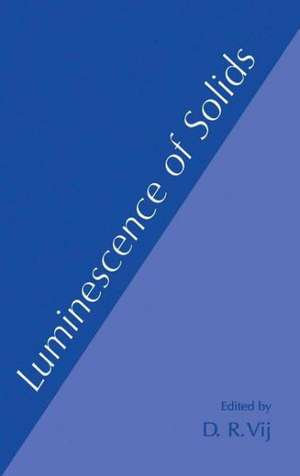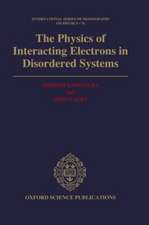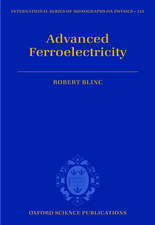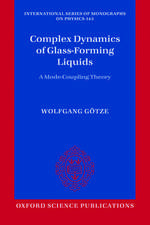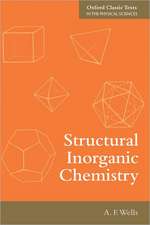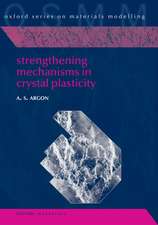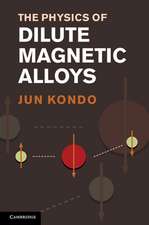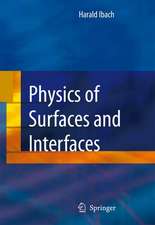Luminescence of Solids
Editat de D.R. Vijen Limba Engleză Paperback – 16 oct 2012
This international collection of cutting-edge luminescence research is complemented by over 170 illustrations that bring to life the text's many vital concepts.
| Toate formatele și edițiile | Preț | Express |
|---|---|---|
| Paperback (1) | 951.59 lei 6-8 săpt. | |
| Springer Us – 16 oct 2012 | 951.59 lei 6-8 săpt. | |
| Hardback (1) | 963.47 lei 6-8 săpt. | |
| Springer Us – 30 iun 1998 | 963.47 lei 6-8 săpt. |
Preț: 951.59 lei
Preț vechi: 1160.48 lei
-18% Nou
Puncte Express: 1427
Preț estimativ în valută:
182.11€ • 197.74$ • 152.97£
182.11€ • 197.74$ • 152.97£
Carte tipărită la comandă
Livrare economică 23 aprilie-07 mai
Preluare comenzi: 021 569.72.76
Specificații
ISBN-13: 9781461374466
ISBN-10: 1461374464
Pagini: 448
Ilustrații: XVII, 427 p.
Dimensiuni: 155 x 235 x 24 mm
Greutate: 0.62 kg
Ediția:Softcover reprint of the original 1st ed. 1998
Editura: Springer Us
Colecția Springer
Locul publicării:New York, NY, United States
ISBN-10: 1461374464
Pagini: 448
Ilustrații: XVII, 427 p.
Dimensiuni: 155 x 235 x 24 mm
Greutate: 0.62 kg
Ediția:Softcover reprint of the original 1st ed. 1998
Editura: Springer Us
Colecția Springer
Locul publicării:New York, NY, United States
Public țintă
ResearchCuprins
1 Theory of Luminescence.- 1. Introduction.- 2. Characteristics of Luminescence.- 3. Fundamentals of the Quantum Theory of Radiation.- 4. Theoretical Models and Mechanisms of Luminescence.- 5. Conclusions and Future Trends.- References.- 2. Experimental Techniques.- 1. Introduction.- 2. Absorption and Luminescence Spectroscopy.- 3. Spectroscopic Components.- 4. Time-Resolved Spectroscopy.- 5. Hole-Burning, Fluorescence Line-Narrowing, and Photon Echo.- 6. Quantum Efficiency and Nonradiative Processes.- 7. Polarization and Perturbation Spectroscopy.- 8. New Developments.- References.- 3. Photoluminescence.- 1. Introduction.- 2. Classification of Photoluminescence in Solids.- 3. Band-to-Band Luminescence.- 4. Wannier Exciton Luminescence.- 5. Characteristics of Localized-Center Luminescence.- 6. Extrinsic Luminescence of Unlocalized Type.- 7. Extrinsic Luminescence of Localized Type.- 8. Luminescence of Low-Dimensional Systems.- References.- 4. Cathodoluminescence.- 1. Introduction.- 2. Fundamental Aspects.- 3. Experimental Aspects.- 4. Materials Applications.- 5. Recent Applications.- 6. Future Trends.- References.- 5. Ionoluminescence.- 1. Introduction.- 2. Models for Excited Atom Formation.- 3. Experimental Observations.- 4. Application to Surface Analysis.- 5. Other Sources of Light Emission.- 6. Conclusions.- References.- 6. Electroluminescence.- 1. Introduction.- 2. ZnS-Type Electroluminescence.- 3. Host Materials and Activators.- 4. Materials Requirements and Deposition Techniques.- 5. Color Electroluminescence Emission of Thin Films.- 6. Stability of ACTFEL Displays and Devices.- 7. Powder Electroluminescence.- 8. Electroluminescence of Organic Materials.- References.- 7. Thermoluminescence.- 1. Introduction.- 2. Thermoluminescence Models.- 3. Thermoluminescence Mechanisms.- 4. Methods of Analysis.- 5. Thermoluminescence-Related Phenomena.- 6. Materials: Preparations and Characteristics.- 7. Thermoluminescence Measurement Methods.- 8. Applications.- References.- 8. Lyoluminescence.- 1. Introduction.- 2. Materials and Mechanisms.- 3. Applications and Future Trends.- References.- 9. Sonoluminescence.- 1. Introduction.- 2. Bubble Dynamics.- 3. Multibubble Sonoluminescence.- 4. Single-Bubble Sonoluminescence.- 5. Mechanisms of Sonoluminescence.- 6. Applications.- 7. Conclusions.- References.- 10. Mechanoluminescence.- 1. Introduction.- 2. Mechanoluminescent Materials.- 3. Mechanoluminescence Measurement Devices.- 4. Mechanoluminescence Characteristics.- 5. Mechanoluminescence Mechanisms.- 6. Mechanoluminescnce Theory.- 7. Applications.- References.- 11. Bioluminescence and Chemiluminescence.- 1. Introduction.- 2. Mechanisms of Chemiluminescence and Bioluminescence.- 3. Chemiluminescence.- 4. Bioluminescence.- 5. Applications of Chemiluminescence and Bioluminescence.- References.
